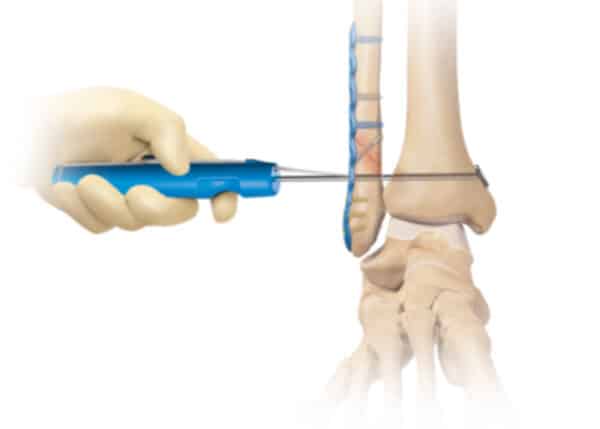Ankle Surgeons
Are you an athlete who participates in sports that involve jumping, landing or running? If so, you may be at a higher risk of sustaining a syndesmosis injury of the ankle. A new advancement in treating severe ankle sprains and fractures has been developed by Arthrex and is called the Syndesmosis TightRope® XP Implant System. Doctor Thomas Haytmanek and Doctor Jonathon Backus use the TightRope system to stabilize the ankle, while allowing for significantly shorter healing times for patients in Vail and Frisco, Colorado, as well as Denver, Boulder, and surrounding Summit County areas who have experienced a syndesmosis injury of the ankle. Contact The Steadman Clinic’s Sports Foot and Ankle team today!

What is syndesmosis of the ankle?
The syndesmosis is the distal articulation of the tibia (shin bone) and fibula as they meet to create the ankle. The joint is held together by three main ligaments with the anterior tibiofibular ligament in the front, the interosseous membrane in the middle, and the posterior tibiofibular ligament in the back of the ankle. This area is sometimes called the distal tibiofibular syndesmosis, and when injured can be referred to has a “high ankle sprain”. Although the syndesmosis is a joint, when our doctors refers to a syndesmotic injury, they are describing the injury of the syndesmotic ligaments.
What is TightRope™ Fixation?
The TightRope™ system was developed to give the ankle support while healing a severe sprain of the syndesmotic ligaments. The device anchors the ends of the tibia and fibula together with a braided polyethylene cord to restore the original position of the bones which allows for proper healing of the ligaments while allowing normal physiologic movement. The TightRope™ system does not require the customary surgical screw, which can sometimes be too rigid and problematic causing pain and subsequent removal. Instead, the tightrope allows the syndesmosis to be stabilized in a flexible manner, which keeps the motion between the tibia and fibula but prevents problematic widening of the bones.

Syndesmosis TightRope® XP Implant System
Image courtesy of Arthrex
Who should consider the TightRope™ System?
Low grade syndesmotic injuries can heal without surgical intervention by limiting weight-bearing and immobilization in a cast or boot. However, when appropriate, the TightRope™ system can shorten rehabilitation times and is therefore an attractive option for athletes which allows them to return to sport more quickly. The fixation is flexible, eliminating the need for a second surgery to remove the surgical screws previous repairs may have required.
What are the advantages of the TightRope™ Implant?
- Improved reduction, compared to syndesmosis screws.
- Less healing time before return-to-sport.
- No need for surgical removal.
- Supports early weight-bearing.
- Sustained flexible alignment.
Is the TightRope™ Implant system FDA approved?
Yes! The TightRope™ Implant system has regulatory clearance by the FDA.
Will the TightRope™ Implant need to be removed?
The TightRope™ Implant is designed to stay in the ankle, offering support throughout healing. Only very rarely would the implant need to be removed. Dr. Haytmanek can explain the benefits and risks if you are a candidate for the TightRope™ Implant.
What is the recovery time for TightRope™ ankle surgery?
Due to the flexibility of the fixation, a second surgery is not required. Rehabilitation can begin much quicker as well as weight bearing. Our surgeons have seen patients return to play as soon as 3-6 weeks.
